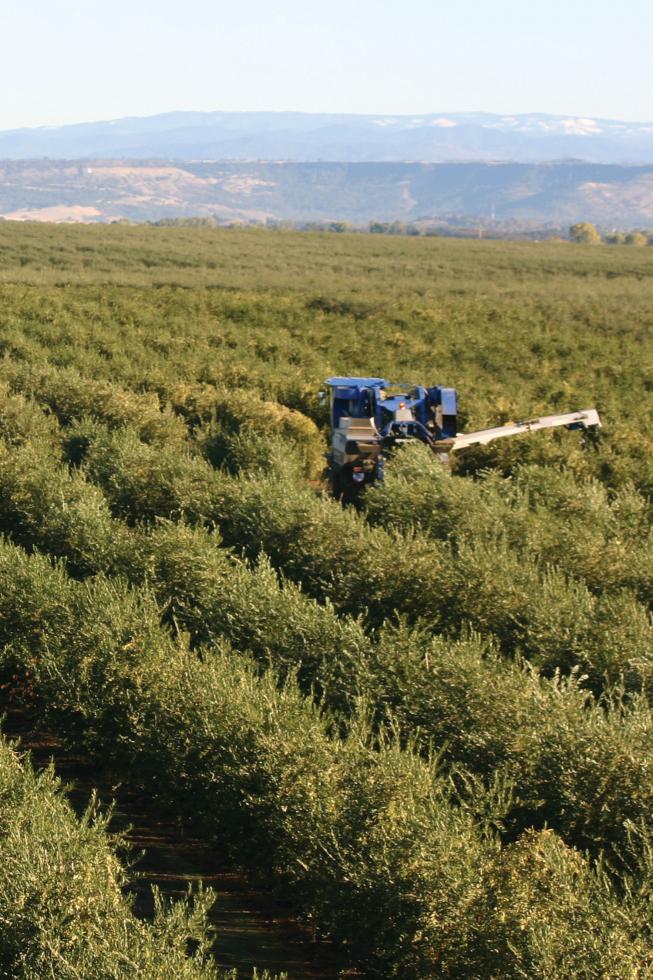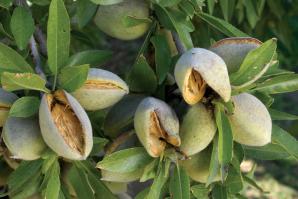California Olive Ranch’s Oroville location during harvest season.
(courtesy of California Olive Ranch)

Americans import 99 percent of the roughly 200,000 tons of olive oil consumed each year. It’s not that the foreign stuff is so much better — in fact a recent study suggests that it often isn’t. The real challenge for domestic producers has been overcoming the enormous labor costs of an agricultural product that must be picked by hand.
Historically the best option for crop efficiency, wherever the olives are grown, has been to let them overripen, shake the trees until the fruit falls and sweep it up. That, however, can lead to several drawbacks in the quality of the olive oil, ranging from fruit that is simply too old, to fruit that is bruised, damaged and dirty.
“High-quality oil requires high-quality fresh fruit, and that’s hard to get with the traditional, cost-effective method of hand-harvest,” says Gregg Kelley, president and CEO of California Olive Ranch in Oroville. “A method of harvesting olives mechanically was sought for decades. And when we found one we knew we’d found a way to produce high-quality oil on a large scale.”
The solution was actually discovered in Spain when a grower decided the answer wasn’t getting the machinery to fit the crop, but getting a crop to fit the machinery.
Mechanical harvest of wine grapes has been around for decades; the epiphany was to find a species of olive similar in size to grapes and of enough quality for oil production. It was found in the Arbequina variety. With some slightly modified grape harvesters and a variation in how olive trees are grown (picture hedgerows instead of traditional orchards) the mechanical age of olive harvesting was born. And as the largest producer of olive oil in the U.S., California Olive Ranch has arguably put it to the best use. According to the California Olive Council, for example, California Olive Ranch accounts for about half of all the oil-producing olives in the state.
“We’ve got just north of 11,000 acres planted, and knowing what we do now, we could eventually get up to 50,000 acres,” Kelley says. We can harvest about one acre per hour with one mechanical harvester. It would take at least 60 people to hand harvest at the same rate.”
The scale of the operation doesn’t end there, as processing of the olives is usually done in a matter of hours — with the fruit arriving at the factory about 20 minutes after it’s picked — compared to days or even weeks for many foreign producers. The company’s production facility in Artois runs 24/7 during harvest and is currently the largest olive oil mill in the nation, producing 80 tons of olive oil an hour.
As for the quality, about 99.9 percent of the oil the company produces exceeds any foreign or domestic standard for “extra virgin,” the highest quality. Surprisingly, however, a healthy percentage of imported extra virgin olive oils do not.
A July 2010 study by the UC Davis Olive Center and the Australian Oils Research Laboratory evaluated the quality of extra virgin olive oils sold on California’s retail shelves. The result: 69 percent of imported oils labeled as extra virgin failed to meet International Olive Council and U.S. Department of Agriculture “sensory” standards for extra virgin olive oil. Sensory defects (flavors that are rancid and musty) are indicators that the oils have been overexposed to oxygen and/or adulterated with cheaper oils and are therefore of lower grade.
“One reason we found these results is that the U.S. standards for olive oil haven’t changed since 1948, and even with those there’s hardly any enforcement,” says Dan Flynn, executive director for the UC Davis Olive Center. “Those standards will finally change this year, but they’re still only voluntary.”
The research findings may be intriguing for industry observers, but what do they really mean to the millions of users who, even right now, still have an old, half-full bottle of Star somewhere in the spice cabinet? The average American consumes about a quart of olive oil a year. The average Greek consumes the same amount every two weeks. Is it that big a deal whether Americans are getting truly extra virgin oil?
The trend data says yes. According to the International Olive Council, U.S., consumption of olive oil rose almost 300 percent between 1991 and 2002 and has continued to rise at a rate of about 8 percent every year. The U.S. is now the third-largest consumer of olive oil in the world behind Italy and Spain, and with greater consumption comes a better appreciation for quality.
“There is no one olive oil for all purposes. For me it’s a very special ingredient, and I don’t treat it as just a commodity,” says Michael Tuohy, executive chef at The Grange Restaurant & Bar in Sacramento. “Believe me, I could go on about olive oil for hours.”
The growing domestic interest and potential market demands for quality are certainly good news for Kelley and other American producers. And there’s still 99 percent of the U.S. olive oil-buying market waiting to be claimed.
“Access to capital is of course an issue as we look ahead,” Kelley says,” but in truth we can hardly plant acreage fast enough to meet demand.”
Recommended For You

Striking Oil
In Woodland, La Tourangelle cracks the nut oil market
Pulling up to the bland business park that is home to La Tourangelle’s nut oil bottling facility gives no indication of the nexus of culinary artistry housed inside.
But step through the doors and start talking to Matthieu Kohlmeyer, the energetic founder and CEO of the Woodland company, and you’ll discover that this quiet farming town is home to a vibrant French connection and a business that’s ridden the wave of consumer health trends and successfully plugged into the farm-to-fork movement.

Tough Nut to Crack
Almonds bust then boom in China
Richard Waycott says there are no silver bullets in the remarkable double-digit growth of California almond exports to China but rather a carefully honed strategy built on introducing almonds to a “pre-existing snacking culture.”


